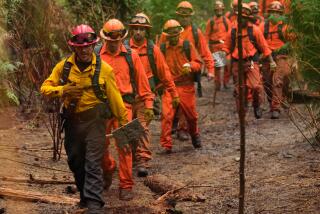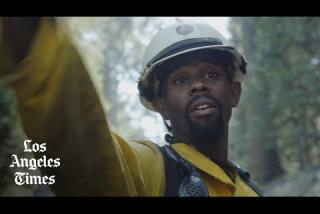Smoke jumper was one of first to make the leap
Earl Cooley, who was one of the first two U.S. Forest Service smoke jumpers to parachute into a forest fire and later was a spotter on the Mann Gulch fire that killed 13 firefighters, has died. He was 98.
Cooley died Nov. 9 at his home in Missoula, Mont., of pneumonia.
As a 23-year-old outdoorsman who had built logging roads, lookout towers and a home for his mother, Cooley was as well prepared as anyone -- which is to say hardly prepared at all -- to jump from a propeller-driven plane into a lightning-triggered fire in Idaho’s Nez Perce National Forest on July 12, 1940. The first man out the plane’s door was Rufus Robinson, followed closely by Cooley.
The wind was blowing so hard that afternoon that Cooley’s load lines twisted up behind his neck. As he bent to look at the emergency chute, the lines unwound. He was nearly in a free fall, and as he drew closer to the ground, he clipped the limbs off a big spruce tree. He landed without injury, as did Robinson, and the pair squelched the fire by 10 a.m. the next day, then hiked 28 miles to the nearest ranger station.
That was the start of the Forest Service’s storied corps of smoke jumpers who even today jump in hazardous, remote areas to quickly control fires that ground-based crews cannot reach. The idea of smoke jumping had been first proposed in 1934 and tried in Russia during that decade, but the act of dropping men into a wildfire with little more than shovels and pickaxes was considered something between experimental and insane.
On the flight in the Nez Perce fire, the man whose job was to shove supplies out after the smoke jumpers almost fell to his death. Merle Lundrigan’s legs got tangled in ropes, and he was pulled out of the plane’s door, barely hanging on to the doorstep. The pilot immediately banked, which tossed Lundrigan back aboard. From then on, cargo kickers had to wear parachutes.
“We didn’t know what we were doing,” Cooley told the Associated Press in 2000.
His training was rudimentary; the trainer had hung a parachute in a tree to point out the harness, shroud lines and release handles, then said: “Tomorrow, we jump.” Still, Cooley said, the only bad part of smoke jumping was the walk home.
Cooley made 48 more jumps. In 1949, he was aboard a C-47 plane from which a dozen smoke jumpers leaped into the Mann Gulch fire near Helena, Mont.
Cooley was the spotter, the man who found the landing site and tapped each jumper on the left calf to alert him it was time to go. The firefighters landed safely and the additional equipment fell to the ground, so Cooley and the plane went back to base. But the fire “blew up” and overran the men in what became the Forest Service’s biggest tragedy until the 1994 South Canyon fire in Colorado.
“Earl lived a very long time, and he was acutely aware of his place in the history of smoke jumping,” said John Maclean, the author of three books on wildland fires, and the son of Norman Maclean, who wrote about the Mann Gulch incident.
John Maclean called Cooley’s 1984 book about the early days of the Forest Service, “Trimotor and Trail: Pioneer Smokejumpers,” “the most authoritative book from the inside about that period.”
Cooley was born Sept. 26, 1911, in Sarpy Creek, Mont. He retired from the Forest Service in 1975.
Survivors include his wife, Irene Cook Cooley; five daughters; two siblings; and 12 grandchildren.
--
Sullivan writes for the Washington Post.
More to Read
Sign up for Essential California
The most important California stories and recommendations in your inbox every morning.
You may occasionally receive promotional content from the Los Angeles Times.










